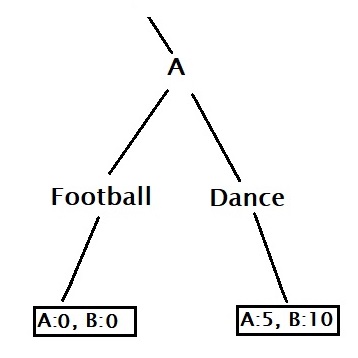We have seen how coordination failure has led the game to a simultaneous move. Now, think about another scenario where there was no network failure, and the communication was possible between A and B. This can lead to another type of game; the sequential move. But before we move on to that, let us look at the original payoff matrix.
| B | |||
| Football | Dance | ||
| A | Football | A:10, B:5 | A:0, B:0 |
| Dance | A:0, B:0 | A:5, B:10 |
In this case, B finishes her job earlier, reaches the dance venue and calls up A. So B becomes the first mover, and A’s strategy now depends on the following game tree (full version).

Now that B has made her move, i.e. dance, the subgame has only the A’s part of the tree.

And the loving A has only one option to select and maximise the couple’s happiness! It has become a subgame perfect Nash equilibrium, favouring the early mover, B in this case.
Not a guaranteed success
Although the present story tells otherwise, there are no rules to guarantee maximum payoff for the first mover. There are several examples where followers benefitted from early movers’ mistakes, especially in businesses that require heavy R&D and are high in fast-evolving technology content. As per this HBR article, gradually evolving technologies and market gives the early mover better chances.

